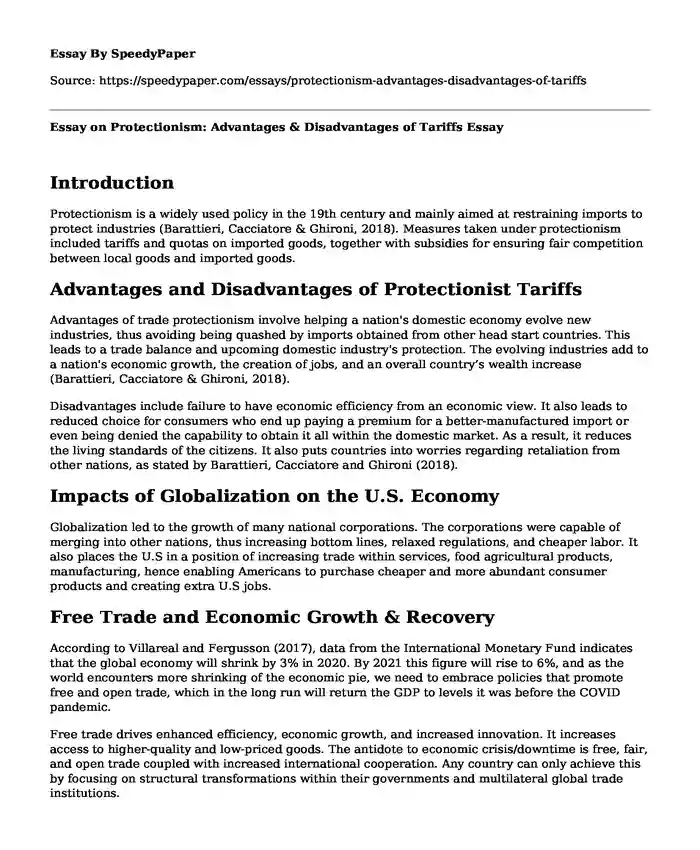
| Type of paper: | Essay |
| Categories: | Policy Politics History Political science |
| Pages: | 2 |
| Wordcount: | 432 words |
Introduction
Protectionism is a widely used policy in the 19th century and mainly aimed at restraining imports to protect industries (Barattieri, Cacciatore & Ghironi, 2018). Measures taken under protectionism included tariffs and quotas on imported goods, together with subsidies for ensuring fair competition between local goods and imported goods.
Advantages and Disadvantages of Protectionist Tariffs
Advantages of trade protectionism involve helping a nation's domestic economy evolve new industries, thus avoiding being quashed by imports obtained from other head start countries. This leads to a trade balance and upcoming domestic industry's protection. The evolving industries add to a nation's economic growth, the creation of jobs, and an overall country’s wealth increase (Barattieri, Cacciatore & Ghironi, 2018).
Disadvantages include failure to have economic efficiency from an economic view. It also leads to reduced choice for consumers who end up paying a premium for a better-manufactured import or even being denied the capability to obtain it all within the domestic market. As a result, it reduces the living standards of the citizens. It also puts countries into worries regarding retaliation from other nations, as stated by Barattieri, Cacciatore and Ghironi (2018).
Impacts of Globalization on the U.S. Economy
Globalization led to the growth of many national corporations. The corporations were capable of merging into other nations, thus increasing bottom lines, relaxed regulations, and cheaper labor. It also places the U.S in a position of increasing trade within services, food agricultural products, manufacturing, hence enabling Americans to purchase cheaper and more abundant consumer products and creating extra U.S jobs.Free Trade and Economic Growth & Recovery
According to Villareal and Fergusson (2017), data from the International Monetary Fund indicates that the global economy will shrink by 3% in 2020. By 2021 this figure will rise to 6%, and as the world encounters more shrinking of the economic pie, we need to embrace policies that promote free and open trade, which in the long run will return the GDP to levels it was before the COVID pandemic.
Free trade drives enhanced efficiency, economic growth, and increased innovation. It increases access to higher-quality and low-priced goods. The antidote to economic crisis/downtime is free, fair, and open trade coupled with increased international cooperation. Any country can only achieve this by focusing on structural transformations within their governments and multilateral global trade institutions.
References
Barattieri, A., Cacciatore, M., & Ghironi, F. (2018). Protectionism and the business cycle (No. w24353). National Bureau of Economic Research. https://doi.org/10.3386/w24353
Villareal, M., & Fergusson, I. F. (2017). The North American Free Trade Agreement (NAFTA). https://doi.org/10.1163/1570-6664_iyb_sim_org_2292
Cite this page
Essay on Protectionism: Advantages & Disadvantages of Tariffs. (2023, Oct 13). Retrieved from https://speedypaper.com/essays/protectionism-advantages-disadvantages-of-tariffs
Request Removal
If you are the original author of this essay and no longer wish to have it published on the SpeedyPaper website, please click below to request its removal:
- Essay Example on Speech Community Collocations in Second Language
- Essay Example on Democratizing the Policy Process
- Stress and Violence in the Workplace, Essay Example
- Free Essay: Why Is the Idea of Liberal Media Bias so Widespread?
- Essay Sample on Slavery, Dueling, and Identity
- Essay Sample on Colonial Conflict: Georgia Sank the Plan to Resolve Native Land Disputes
- Essay Sample - Planning and Social Outcomes
Popular categories




